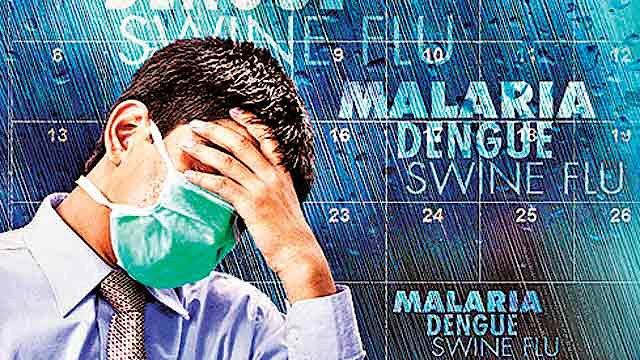Preventive measures of Monsoon Diseases
Lifeline labs the best pathology in Lucknow shares a blog on monsoon diseases and its preventive measures. Monsoon is not only about having a cup of hot tea with a plate of snacks and enjoying the view of raindrops falling on the ground refreshing the environs. Along with all this is also comes with lot of monsoon diseases. This picture perfect situation disappears when you step out of your home on a rainy day.
Here are the few most common monsoon
diseases that you need to look out. While most of these are treatable to quite
an extent, some qualify as fatal and life-threatening diseases and must be
treated at the earliest to avoid facing consequences. Follow preventive measures shared by best pathology in Lucknow and keep yourself and your loved onces healthy and fir this monsoon
1) Dengue
This mosquito borne disease has, over the past decade, taken the lives of many. Dengue is quite common during the monsoon season for the reason that it’s the time of the year that mosquitoes get favorable conditions to breed and spread infection. When a person is injected with the virus of Dengue, he/she is expected to witness symptoms like persisting headache, high fever, rashes, and pain in the muscles and the joints. In severe cases, one may experience severe bleeding and shocks, which can be life threatening.
Causes of Dengue: When an infected mosquito bites a human, it injects one of the four known viruses of Dengue into his/her the bloodstream. Furthermore, the mosquito either picks this virus from an already infected person, or from surrounding environs. However, physicians claim that once a person fully recovers from Dengue, he/she acquires lifetime immunity for that types of dengue virus.
Prevention against Dengue:
1. Sleeping in Mosquito beds is a good way to prevent yourself from mosquito bites.
2. Aerosol and liquid sprays are a good way to effectively kill mosquito.
3. Try and wear long-sleeved clothes when going outside.
4. You can prevent yourself from mosquito bites by applying insect repellent on clothes or on the skin, especially that’s exposed.
2) Chikungunya
Chikungunya is quite similar to Dengue fever. It is also spread by the bite of an infected mosquito. Chikungunya, though, is not fatal in nature, but highly painful and traumatizing. Medical reports of 2016 claim that about 12,000 cases of Chikungunya were reported in Delhi itself, let alone the entire nation. The mosquito-borne disease causes fever and severe joint pain that lasts for weeks. Other symptoms include headache, muscle pain, fatigue, nausea, and rashes.
Causes of Chikungunya: Chikungunya is transmitted by the bite of an infected Aedes albopictus mosquito. The mosquito type breeds in stagnated water and bites during the bright daylight only.
1. Prevention against Chikungunya: There is no particular cure available for the disease. Treatment usually focuses on relieving the symptoms.
2. Use air conditioning or window/door screens to keep mosquitoes from entering your premises. You can also use the bed net.
3. Wear long – sleeved shirts and long pants.
4. Use insect repellents.
5. You can use Sunscreen and insect repellents. Apply the sunscreen first and then repellent.
3) Jaundice
Jaundice is a condition wherein the color of the skin and the eyes turns yellow. It is the cause of increased levels of bilirubin in the bloodstream.
The color of the skin and sclera varies depending up on raised level of bilirubin; mildly elevated levels display yellow skin and sclera, while highly elevated levels display brownish color. Jaundice can be caused by a number of conditions, typically including the inflammation of the liver and the presence of an obstruction in the bile duct.
Causes of Jaundice: Jaundice may be caused by a number of diseases. The best way to know the kind of Jaundice type you have is by identifying the problems that disrupt the normal bilirubin metabolism and/or excretion.
Pre-hepatic (pre bile production stage) – In this case Jaundice is a result of rapid increase in the breakdown and destruction of the red blood cells (hemolysis), overwhelming the liver’s ability to adequately remove the increased levels of bilirubin from the blood.
Post-hepatic (after bile has been made in the liver) – Jaundice, in such a case, is also termed as obstructive jaundice. This is caused by conditions that interfere with the normal drainage of conjugated bilirubin, in the form of bile, from the liver into the intestines. Causes of obstructive jaundice include:
a. Gallstones in the bile ducts,
b. Cancer (pancreatic and gallbladder/bile duct carcinoma),
c. Strictures of the bile ducts,
d. Cholangitis,
e. Congenital malformations,
f. Pancreatitis,
g. Parasites,
h. Pregnancy, and
i. Newborn jaundice.
j. Also, check out some common causes of newborn jaundice:
k. Physiological jaundice
l. Maternal-fetal blood group incompatibility (Rh, ABO)
m. Breast milk jaundice
n. Breastfeeding jaundice
o. Cephalohematoma (a collection of blood under the scalp)
Prevention against Jaundice: Here are some of the ways to prevent Jaundice on time:
1. Vaccines for hepatitis (hepatitis A, hepatitis B)
2. Avoid heavy alcohol consumption
3. Take medications which prevent malaria before traveling to high-risk regions.
4. Avoid potentially contaminated foods/water intake and maintain a good hygiene

Comments
Post a Comment